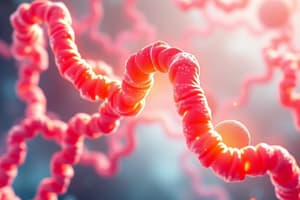Podcast
Questions and Answers
What type of bond is formed between the α-amino and carboxyl groups of amino acids?
What type of bond is formed between the α-amino and carboxyl groups of amino acids?
- Ionic bond
- Van der Waals force
- Hydrogen bond
- Peptide bond (correct)
What is the result of the reaction between Gly and Ala?
What is the result of the reaction between Gly and Ala?
- Polypeptide
- Tripeptide
- Dipeptide (correct)
- Glycyl-alanine (correct)
Which type of interaction is characterized by the sharing of electrons?
Which type of interaction is characterized by the sharing of electrons?
- Covalent bond (correct)
- Hydrogen bond
- Electrostatic interaction
- Van der Waals force
What causes denaturation in proteins due to temperature changes?
What causes denaturation in proteins due to temperature changes?
Which of the following describe the denaturation effect due to pH changes?
Which of the following describe the denaturation effect due to pH changes?
What is an example of a denaturing agent used in laboratories to study proteins?
What is an example of a denaturing agent used in laboratories to study proteins?
Which type of interaction occurs at distances of 3-5 Å?
Which type of interaction occurs at distances of 3-5 Å?
What is the energy range (in kcal/mol) associated with covalent bonds?
What is the energy range (in kcal/mol) associated with covalent bonds?
Flashcards
Peptide Bond
Peptide Bond
A covalent bond formed between the α-amino group of one amino acid and the carboxyl group of another amino acid, resulting in the release of a water molecule.
Peptides
Peptides
Molecules formed by the linking of two or more amino acids via peptide bonds.
Primary Structure
Primary Structure
The linear sequence of amino acids in a protein chain.
Denaturation
Denaturation
Signup and view all the flashcards
Heat Denaturation
Heat Denaturation
Signup and view all the flashcards
pH Denaturation
pH Denaturation
Signup and view all the flashcards
Denaturation by Detergents
Denaturation by Detergents
Signup and view all the flashcards
Sodium Dodecyl Sulfate (SDS)
Sodium Dodecyl Sulfate (SDS)
Signup and view all the flashcards
Study Notes
Peptide and Peptide Bonds
- Amino acids are covalently linked forming an amide bond between the α-amino and carboxyl groups.
- This bond is called a peptide bond.
- The products formed from amino acid unions are called peptides.
- Linking two amino acids creates a dipeptide (e.g., Gly-Ala).
- This reaction is considered a simple elimination of a water molecule.
Protein Structures and Interactions
- Table of Protein Interactions
- Type | Mechanism | Energy (kcal/mol) | Interaction Distance (Å) | Interacting groups
- Covalent | Electron sharing | 30-100 | 1-2 | C-C, C-N, C=O, C-S, C-N-C
- Electrostatic/Salt Bridges | Coulombic attraction between opposite charges | 10-20 | 2-3 | -NH3+, -COO-
- Hydrogen Bonds | Shared hydrogen between electronegative atoms | 2-10 | 2-3 | -N-H···O=C-, -N-H···O-H
- Van der Waals | Induced dipole moments in polar groups | 1-3 | 3-5 | Polar groups
Protein Denaturation
- Temperature Changes: Heat is a common denaturing agent used in food processing assisting in protein digestion. It also disables inhibitors.
- pH Changes: A change in pH can lead to significant protein conformation modifications due to ionization changes in charged side chains and affect the amount of stabilizing salt bridges.
- Detergents: Denaturing proteins with detergents, (e.g., SDS), is common in lab settings. Detergents' amphiphilic nature helps with this process.
Studying That Suits You
Use AI to generate personalized quizzes and flashcards to suit your learning preferences.




